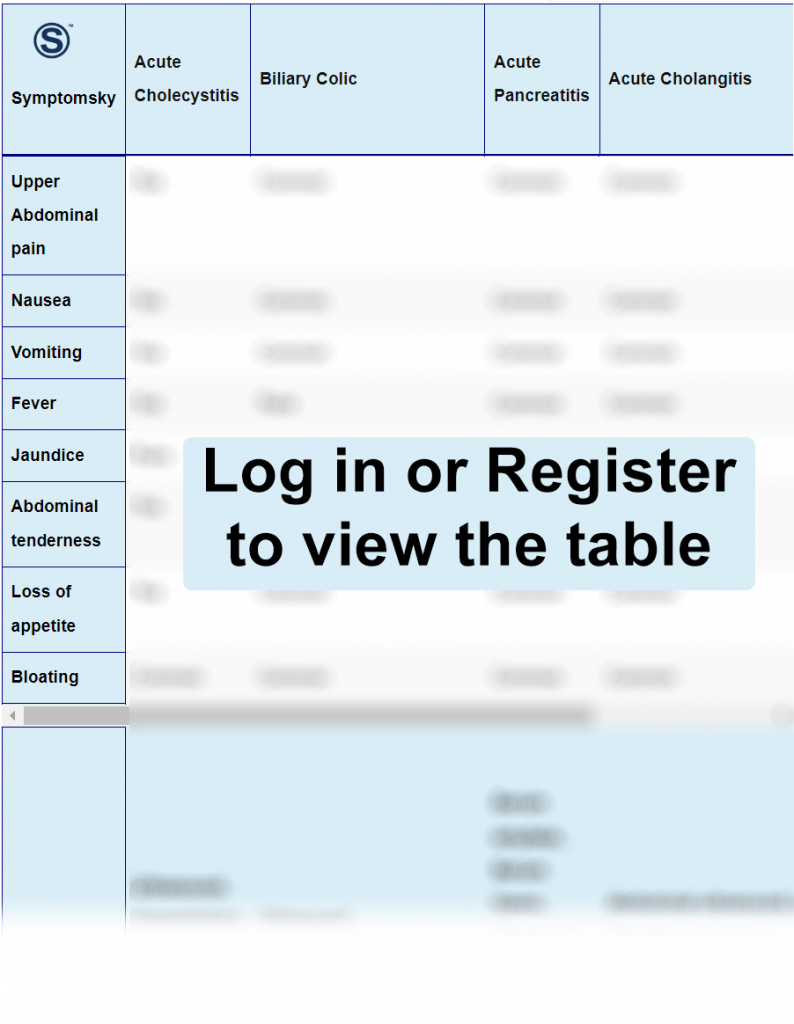Contents
- 1 Acute Cholecystitis Differential Diagnosis Table:
- 2 How to Distinguish Acute Cholecystitis from Other Diseases
- 2.1 Distinguish Biliary Colic from Acute Cholecystitis – Diagnosis
- 2.2 Distinguish Acute Pancreatitis from Acute Cholecystitis – Diagnosis
- 2.3 Distinguish Acute Cholangitis from Acute Cholecystitis – Diagnosis
- 2.4 Distinguish Viral Hepatitis from Acute Cholecystitis – Diagnosis
- 2.5 Distinguish Alcoholic Hepatitis from Acute Cholecystitis – Diagnosis
- 3 Common Red Flags With Acute Cholecystitis
Acute Cholecystitis Differential Diagnosis Table:

Acute cholecystitis is the inflammation of the gallbladder.
The gallbladder is a paired sac-shaped organ located below the liver, is the size of a small pear and is part of the hepato-biliary system which is attached through the cystic duct. The main function of the gallbladder is to store and concentrate hepatic bile during fasting.
The most frequent cause of acute cholecystitis is the obstruction of the cystic duct, which is the cause of more than 90% of the cases. There are other less frequent causes such as acute acalculous cholecystitis which means the absence of stones inside the gallbladder, is more common in critically immunosuppressed patients, or patients with renal transplants.
This condition is more prevalent in women than men. Some risk factors include: being female, obesity, pregnancy, rapid weight loss, high fat or low fiber diet.
The main symptom of acute cholecystitis is acute abdominal pain. It is a constant pain located in the right hypochondrium lasting more than five hours towards the scapula or back and is often accompanied by nausea, vomiting, and fever. Physical examination shows hypersensitivity to palpation in the right hypochondrium and ceases during inspiration (Murphy’s sign).
During my practice, most of the acute cholecystitis I saw were in the emergency department. Usually women over 40 years of age with no known morbidity history presenting positive Murphy’s sign, fever, nausea, and vomiting for three days. Unfortunately, most of the cases I saw were already complicated patients who underwent laparoscopic cholecystectomy but hospital stay was long due to complications. I did not actually see any patients die from this condition but their general condition was acutely ill, especially in the pre-operative stage where the patient looked extremely ill and was screaming in pain.
How to Distinguish Acute Cholecystitis from Other Diseases
Distinguish Biliary Colic from Acute Cholecystitis – Diagnosis
Biliary Colic is an intense pain located in the upper right middle part of the abdomen.
- The biggest difference between Biliary Colic and Acute Cholecystitis is the absence of fever in Biliary Colic.
Distinguish Acute Pancreatitis from Acute Cholecystitis – Diagnosis
It is an inflammatory process of the pancreas.
- Pancreatitis, unlike Acute Cholecystitis, is associated with smoking, consumption of alcohol, intestinal conditions, and kidney disease.
- Pancreatitis is more prevalent in men while Acute Cholecystitis is more prevalent in women.
- Pancreatitis treatment, unlike Acute Cholecystitis, will consist of fluid maintenance, use of analgesic, and antibiotics as long as it is not a cause of cholelithiasis or trauma.
Distinguish Acute Cholangitis from Acute Cholecystitis – Diagnosis
It is an infection of the bile ducts.
- In Acute Cholangitis, unlike Acute Cholecystitis, there is an infection and obstruction of the bile ducts.
- In Acute Cholangitis, unlike Acute Cholecystitis, patients may have manifestations of shock and altered level of consciousness which is known as Reynold’s pentad.
- The diagnostic imaging used in Acute Cholangitis are: transabdominal ultrasound and ERCP while in Acute Cholecystitis, CT and ultrasound are used.
Distinguish Viral Hepatitis from Acute Cholecystitis – Diagnosis
It is the generalized inflammation of the liver.
- Viral Hepatitis, unlike Acute Cholecystitis, is caused by viruses.
- Some of the Viral Hepatitis (A and B), unlike Acute Cholecystitis, can be prevented by vaccines.
Distinguish Alcoholic Hepatitis from Acute Cholecystitis – Diagnosis
Alcoholic Hepatitis is the inflammation of the liver due to excessive alcohol consumption
- Alcoholic Hepatitis is more prevalent in men while Acute Cholecystitis is more prevalent in women.
- Alcoholic Hepatitis treatment, unlike Acute Cholecystitis, is the abandonment of alcohol consumption with the help of counseling and medications for liver damage already produced.
Common Red Flags With Acute Cholecystitis
The diagnostic criteria for acute cholecystitis are by clinical suspicions that are already described, laboratory tests which are a complete blood count that will show leukocytosis and neutrophilia, elevated CRP, accelerated erythrocyte sedimentation, and elevated serum amylase.
Diagnostic imaging can be done by abdominal radiography, ultrasound, or CT. Abdominal radiography is not the best method for the diagnosis but it is important if we are considering a differential diagnosis of acute abdomen. CT is also not the method of choice to evaluate this pathology, CT will show increased vesicular diameter, thickening of the vesicular wall but this method is used for complications of acute cholecystitis. Ultrasound is the gold standard for the diagnosis of acute cholecystitis which will present the following signs: thickening and wall distention of the gallbladder, change in its morphology, presence of stones, echogenic Murphy’s sign, and presence of gas within the gallbladder.
Definitive therapeutic options include: cholecystectomy either laparoscopically or by open surgery and drainage by percutaneous cholecystostomy or ultrasound-guided endoscopic drainage. Treatment will depend on the severity and condition of the patient but usually cholecystectomy is the emergency alternative in case of necrosis or complications such as emphysematous cholecystitis or gallbladder perforation.
The most important complications of acute cholecystitis are: empyema and perforation. Empyema is caused by the accumulation of pus inside the gallbladder, Perforation is caused by the perforation of the gallbladder due to ischemia and necrosis of the wall by vascular alterations. There are others such as: hemorrhagic cholecystitis, gangrenous cholecystitis, and emphysematous cholecystitis.
